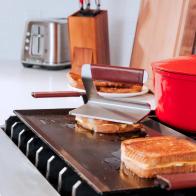
- Level: Easy
- Total: 22 min
- Prep: 10 min
- Cook: 12 min
- Yield: 17 to 18
-
- Nutritional Analysis
- Per Serving
- Serving Size
- 1 of 18 servings
- Calories
- 152
- Total Fat
- 5 g
- Saturated Fat
- 2 g
- Carbohydrates
- 22 g
- Dietary Fiber
- 1 g
- Sugar
- 1 g
- Protein
- 4 g
- Cholesterol
- 17 mg
- Sodium
- 209 mg
Last summer, I gave up going abroad and took a staycation in Cornwall. Apart from one gorgeous, glinting day, it rained and blustered and blew, and I loved it. There I was, with a fire burning inside, the mackerel-coloured sea swirling outside, living off the fat, that's to say, the clotted cream of the land.
If you can't find clotted cream (sometimes called Devonshire cream) then feel free to lavishly spoon softly heavy whipped cream onto the scones instead. The buttermilk in these scones only gives them a slight tang, all the better to enjoy the jam and cream on top, but is also what yields such a melting, tender crumb.
These scones do look a bit like they are suffering from cellulite (though I dare say we all might, if we ate too many of them), but proper scones should not have the smooth-sided denseness of the store-bought variety. And they are so worth making. Until you have made a batch of scones you won't have any idea how easy they are to throw together. Frankly, it shouldn't take longer than 20 minutes to make and bake them, from start to finish.
Even though the process is hardly lengthy enough to warrant cooking them in advance, I like to make up quite a big batch - and this recipe will give you about 18 scones - and freeze some (they thaw incredibly quickly) to produce a near-instant cream tea at some future date.
- Level: Easy
- Total: 22 min
- Prep: 10 min
- Cook: 12 min
- Yield: 17 to 18
-
- Nutritional Analysis
- Per Serving
- Serving Size
- 1 of 18 servings
- Calories
- 152
- Total Fat
- 5 g
- Saturated Fat
- 2 g
- Carbohydrates
- 22 g
- Dietary Fiber
- 1 g
- Sugar
- 1 g
- Protein
- 4 g
- Cholesterol
- 17 mg
- Sodium
- 209 mg
Ingredients
Directions
- Preheat the oven to 425 degrees F and line a large lipped baking sheet with parchment paper.
- Put the flour into a bowl with the baking soda, cream of tartar, and sugar. Chop the butter and the vegetable shortening into pieces and drop them into the flour. Rub the fats into the flour - or just mix any old how - and then pour in the buttermilk, working everything together to form a dough.
- Lightly flour your work surface. Pat the dough into a round-edged oblong about 1 3/4 inches thick and cut out 2-inch scones with a biscuit cutter. (Mine are never a uniform height, as I only pat the dough into its shape without worrying whether it's irregular or not.)
- Arrange the scones fairly close together on your lined baking sheet, and brush with beaten egg (to give golden tops) or not as you wish.
- Bake for 12 minutes, by which time the scones will be dry on the bottom and have a relatively light feel. Remove them to a wire rack to cool, and serve with clotted cream and your favourite jam.
- Make Ahead Note: Scones are best on the day they are made but day-old scones can be revived by warming in oven preheated to 300 degrees F for 5 to 10 minutes.
- Freeze Note: Baked scones can be frozen in airtight containers or resealable bags for up to one month. Thaw for 1 hour at room temperature and warm as above. Unbaked scones can be put on parchment-lined trays and frozen until solid. Transfer to resealable bags and freeze for up to 3 months. Bake direct from frozen, as directed in recipe, but allowing extra 2 to 3 minutes baking time.

































